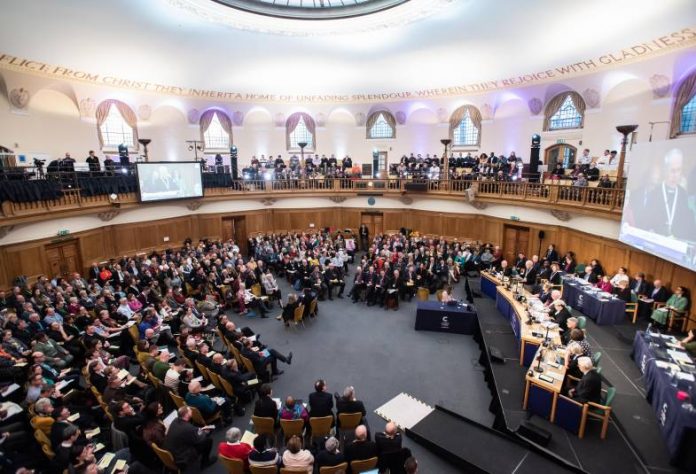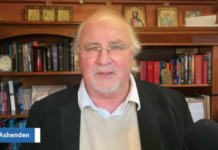AUTHOR’S NOTE: Shortly before General Synod, in the light of what I had earlier written at the start of the discernment process concerning what was needed from the bishops and possible ways forward, I argued for a pause rather than a rush to judgment in the form of a vote. This did not happen and now, a month on from the marathon debate spread over two days (and able to viewed here and here) and with a meeting of the College of Bishops imminent on Thursday 23rd March, it is perhaps good to take stock on where we are in three parts:
- Look back at what the bishops proposed and their original motion (passed with one amendment by 250 members for to 181 against and with 10 abstentions, though only just in the House of Laity where the vote was basically 52/48) and the reception of it particularly in the light of the voting in Synod.
- Look at some key theological and legal issues particularly given the Cornes amendment (to “endorse the decision of the College and the House of Bishops not to propose any change to the doctrine of marriage, and their intention that the final version of Prayers of Love and Faith should not be contrary to or indicative of a departure from the doctrine of the Church of England”) added to that original motion by Synod.
- Look ahead at some of the challenges facing us as a church, particularly the bishops seeking to implement their response post-Synod.
Looking back – The Bishops’ Response to LLF and Synod’s Response to the Bishops
Personally, one of the biggest disappointments I felt about the Bishops’ response to LLF was that it lacked a clearly articulated, substantial theological rationale for their proposals which drew on the work of LLF and sought to locate the bishops’ approach within the wider theological disagreements that LLF mapped out. As I have sought to understand the bishops’ proposals in relation to commending Prayers of Love and Faith and why so many bishops who hold to traditional teaching have, it seems, supported them, I have tried to construct a case for them that might be heard by those who feel compelled to resist their proposals. In so doing I have drawn on their original paper with its response to LLF and also later comments such as the account given by the Bishop of London to General Synod and especially the letter written by the Bishop of Coventry (who chaired the LLF process) to his diocese after the bishops’ response was published.
Ten years ago, I co-edited The Evangelical Alliance’s resource, Biblical and pastoral responses to homosexuality. In that we moved beyond the simple previous binary distinction which is often made in relation to sexuality, especially homosexuality, between orientation and practice and the judgment that while homosexual orientation should not be condemned, all homosexual practice was wrong. Drawing on the work of Mark Yarhouse we highlighted that “orientation” included attraction, orientation and identity and in relation to practice we distinguished between relationships and practice. We summed up this new 5-fold category in these terms (p 28):
There are thus five distinct categories which need to be considered if we are to understand (homo)sexuality:
- Attraction – our sexual feelings and interests
- Orientation – a perceived settled pattern to our sexual attractions
- Identity – a label to identify ourselves in terms of our sexuality
- Behaviour – our sexual activity
- Relationship – a central, defining intimate relationship
In relation to this categorisation, it seems to me that the bishops, aided by the LLF resources, are being driven by two fundamental concerns with which it might be hoped (almost?) all would at least broadly have some sympathy.
Firstly, in relation to the first three categories that those who experience same-sex attraction or orientation and/or who identify as gay, lesbian or bi have been – and often continue to be – treated badly by the church. As a result, they feel rejected and often keep their distance from the church’s life even if they are followers of Jesus and have been committed in the past to sharing in the church’s life and mission. Faced with this reality, the church needs to repent, apologise, and change so as to be more clearly welcoming.
Secondly, in relation to the last of the five categories, that many of these people are in (or seek to be in) some form of “central, defining intimate relationship”. This is often now legally recognised as a civil partnership or civil marriage. Such relationships embody goods, involve embracing moral disciplines, and display a range of virtues which they require and whose nurture and cultivation they enable. The church has, however, failed to acknowledge this adequately, or even at all, in the past and thereby further alienated those in such relationships. This has also meant that those, both Christians and non-Christians, in such relationships and those among their family and friends who see the goods, moral disciplines, and virtues present in them cannot understand why the church apparently does not see them. They are often, as a result, confused and angered that the church appears, in Rowan Williams’ words, to hold that these relationships “have the nature of sin and nothing else”, a moral assessment which they, like him, can only view as “unreal and silly” or even, increasingly, as immoral (“The Body’s Grace”).
Alongside this, thirdly, the bishops are clear that all Christians are called to “walk together” as brothers and sisters united to one another in Christ by faith and baptism and to “make every effort to keep the unity of the Spirit through the bond of peace” (Ephesians 4:3). They have sought to agree proposals that might enable the highest degree of communion possible across our deep differences which are set out in both the LLF resources and the range of responses to them captured in Listening with Love and Faith.
These three convictions have sadly often got lost in the focus on specifics but they are ones which all of us – particularly those of us who cannot accept the bishops’ proposals – need to engage with and they need to shape any alternative way forward.
One such alternative of course was the proposal the bishops brought after the Shared Conversations in GS2055. Although it was lost (by 7 votes) in the House of Clergy and thus seen as a total failure, those proposals had an overall majority across Synod of 58 (60 if you correct for the one bishop who admitted he pressed the wrong button!), not much smaller than the 69 for the current proposal. GS2055 spoke of the need for “interpreting the existing law and guidance to permit maximum freedom within it, without changes to the law, or the doctrine of the Church” (para 22) and later commended “an unambiguous position on doctrine in this matter while enabling a generous freedom for pastoral practice that does not directly and publicly undermine it” (para 65). In many ways what is being proposed is in line with this stance but with a key shift which it appears is now thought legitimate when it was not before: GS2055 considered and rejected (paras 40-43) any new forms of service but we now have such services including of blessing as part of Prayers of Love and Faith (rather than, for example, as the South African bishops have, subsequently done, “accepted that we are not of one mind on this matter. The divisions within the Synod of Bishops reflect the divisions in the Church as a whole, and we are not at peace with one another on this issue” so what is needed is “guidelines on the form of prayers we are to use” in private contexts where there could be “prayers of affirmation and acknowledgement for all faithful Anglicans with which all of us can agree”).
For me, and the votes in Synod and wider reactions suggests for many others, there are at least two significant problems with the bishops’ proposals and these can be related to the last two of the 5 categories listed above. Firstly, they have as yet totally failed to address the crucial question of sexual behaviour and the Bible’s teaching and consequent church teaching about sexual immorality. Secondly, they have also failed to give a convincing account of how the relationship of marriage as the church has received it and they have reaffirmed it should be related to these other patterns of relationship with their particular goods, disciplines and virtues. Instead, they have simply asserted that there is a need “to uphold and celebrate the Christian vision and inherent goodness of faithful and permanent relationships in both marriage and other committed relationships between two people” (Bishop of London) or that they want to “joyfully affirm and…acknowledge in church, stable, committed relationships between two people – including same-sex relationships” (GS 2289, p. 1). Aware of this challenge, they have sought to distinguish “holy matrimony” from civil marriage as mutually exclusive concepts and institutions and seemed to suggest that as long as they are not claimed to be “holy matrimony” the church can celebrate, affirm, acknowledge and bless a variety of forms of such intimate relationships. As I set out in some detail previously, the bishops’ new approach here is significantly at variance with past statements (and in apparent tension with the Bishop of London’s claim at General Synod that “There is no question of reneging on the validity” of the understanding that “opposite sex couples who have been civilly married are understood as being married in the sight of God and of the Church”) and creates major problems.
Read it all at Fulcrum



